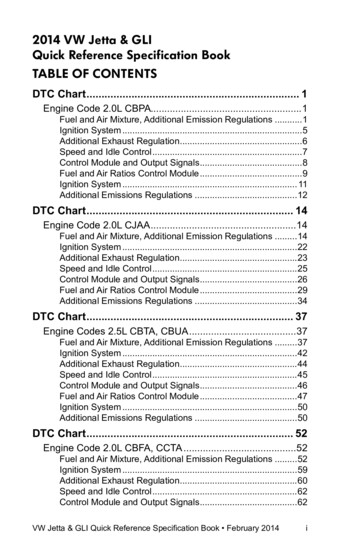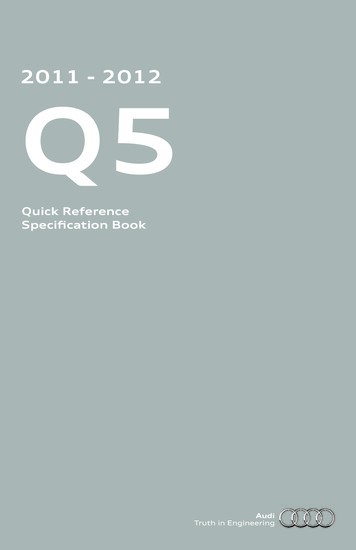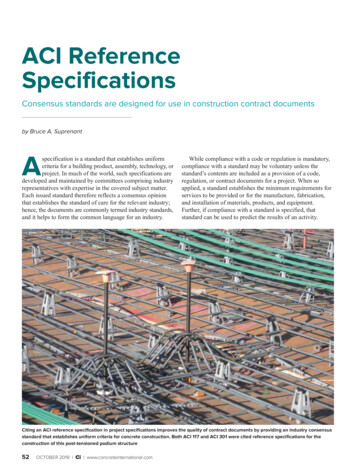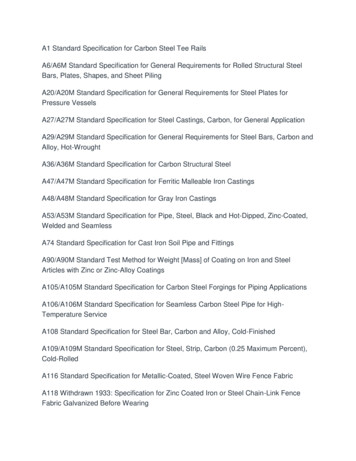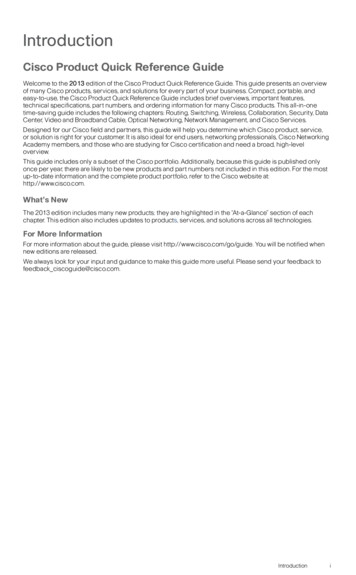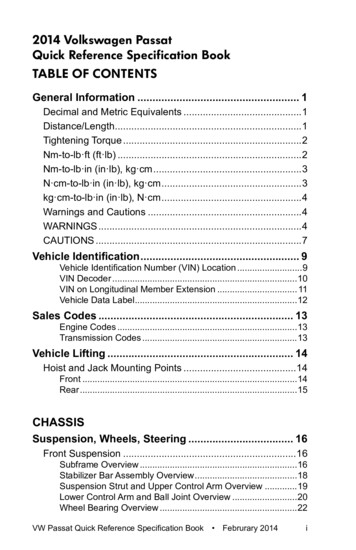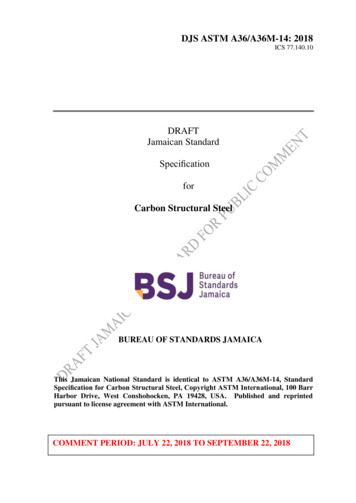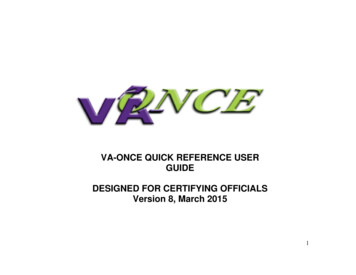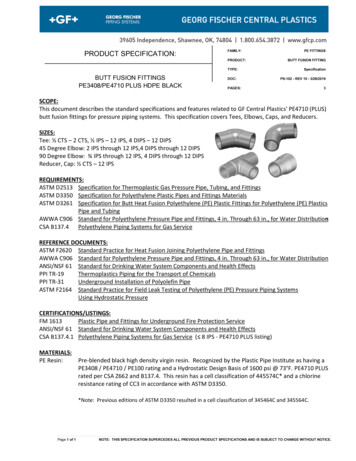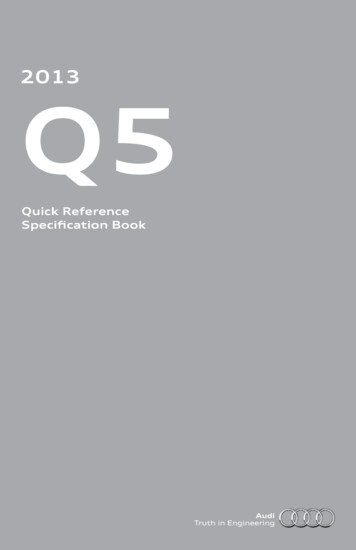
Transcription
2013Q5Quick ReferenceSpecification Book
2013 Audi Q5Quick Reference Specification BookTable of ContentsGeneral Information. 1Decimal and Metric Equivalents.1Tightening Torque.2Warnings and Cautions.4Vehicle Identification. 9Vehicle Identification Number (VIN) Location.9VIN Decoder.10Vehicle Identification Number Decoder Type PlateLocation. 11Vehicle Data Label Location.12Sales Codes. 13Engine Codes.13Transmission Codes.13Vehicle Lifting. 14Lifting Points for Lifting Platform and Trolley Jack.14ENGINESEngine Mechanical – 2.0L CPMA, CHJA. 15General, Technical Data – 2.0L CPMA, CHJA.15Engine Number Location.15Engine Data.16Engine Assembly – 2.0L CPMA, CHJA.16Fastener Tightening Specifications.16Crankshaft, Cylinder Block – 2.0L CPMA, CHJA.17Cylinder Block Bearing Shell Identification.17Bearing Cap Bearing Shell Identification.19Fastener Tightening Specifications.20Crankshaft Dimensions.20Piston Ring End Gaps.20Piston Ring Clearance.20Piston and Cylinder Dimensions.20Accessory Assembly Bracket Tightening Specifications.21Sealing Flange Tightening Specifications.22Crankshaft Assembly Tightening Specifications.23Audi Q5 Quick Reference Specification Book January 2013i
Cylinder Head, Valvetrain – 2.0L CPMA, CHJA.24Fastener Tightening Specifications.24Valve Dimensions.25Compression Pressures.25Cylinder Head Removal Specifications.26Cylinder Head Tightening Specifications.27Cylinder Head Cover Tightening Specifications.28Crankcase Ventilation Tightening Specifications.29Upper Timing Chain Cover Tightening Specifications.29Lower Timing Chain Cover Tightening Specifications.30Lubrication – 2.0L CPMA, CHJA.31Fastener Tightening Specifications.31Upper Oil Pan Tightening Specifications.31Oil Pan Tightening Specifications.32Oil Separator Tightening Specifications.32Engine Cooling – 2.0L CPMA, CHJA.33Fastener Tightening Specifications.33Coolant Pump Tightening Specifications.34Fuel Supply – 2.0L CPMA, CHJA.34Fastener Tightening Specifications.34Turbocharger – 2.0L CPMA, CHJA.35Fastener Tightening Specifications.35Turbocharger Tightening Specifications.36Exhaust System – 2.0L CPMA, CHJA.37Fastener Tightening Specifications.37Fuel Injection and Ignition – 2.0L CPMA, CHJA.38Technical Data.38Fastener Tightening Specifications.39Engine Mechanical – 3.0L CTUC. 40General, Technical Data – 3.0L CTUC.40Engine Number Location.40Engine Data.41Engine Assembly – 3.0L CTUC.42Fastener Tightening Specifications.42Crankshaft, Cylinder Block – 3.0L CTUC.43Allocation of Crankshaft Bearing Shells for Cylinder Block.43Allocation of Crankshaft Bearing Shells for Guide Frame.44Fastener Tightening Specifications.45Ribbed Belt Sealing Flange Tightening Specification.46Guide Frame Tightening Specifications.47Crankshaft Dimensions.48iiAudi Q5 Quick Reference Specification Book January 2013
Piston Ring End Gaps.48Piston Ring Clearance.48Piston and Cylinder Dimensions.48Compression Checking Specifications.48Cylinder Head, Valvetrain – 3.0L CTUC.49Fastener Tightening Specifications.49Valve Dimensions.50Cylinder Head Tightening Specifications.51Left Cylinder Head Cover Tightening Specification.52Right Cylinder Head Cover Tightening Specification.53Left Timing Chain Cover Tightening Specifications.54Right Timing Chain Cover Tightening Specifications.55Lower Timing Chain Cover Tightening Specifications.56Engine Lubrication – 3.0L CTUC.58Fastener Tightening Specifications.58Upper Oil Pan Tightening Specifications.59Oil Pan Tightening Specifications.60Cooling System – 3.0L CTUC.61Fastener Tightening Specifications.61Turbocharger, Supercharger – 3.0L CTUC.62Fastener Tightening Specifications.62Exhaust System, Emission Controls – 3.0L CTUC.62Fastener Tightening Specifications.62Left Exhaust Manifold Tightening Specifications.63Right Exhaust Manifold Tightening Specifications.64Fuel Supply – 3.0L CTUC.64Fastener Tightening Specifications.64Fuel Injection and Ignition – 3.0L CTUC.65Ignition Technical Data.65Fastener Tightening Specifications.65Lower Intake Manifold Tightening Specifications.66Control Valve Control Module Tightening Specification.67Control Valve Control Module Tightening Specification.68TRANSMISSIONSAutomatic Transmission – 0BK. 69General, Technical Data – 0BK.69Transmission Identification.69Transmission Code and Transmission Serial Number.70Code Letters, Transmission Allocations, Ratios andEquipment.70Audi Q5 Quick Reference Specification Book January 2013iii
Securing Transmission to Engine.71Fastener Tightening Specifications.72Gears, Hydraulic Controls – 0BK.72Fastener Tightening Specifications.72ATF Oil Pan Tightening Specifications and Sequence.73Mechatronic Tightening Specification.74Rear Final Drive, Differential – 0BK.75Front Final Drive Cover Tightening Specifications.75Center Differential Housing Tightening Specifications.76Automatic Transmission – 0BW. 77General, Technical Data – 0BW.77Transmission Identification.77Transmission Code Letters and Serial Numbers.78Specifications – Engine Codes, Allocation, Ratios andCapacities.79Controls, Housing – 0BW.79Fastener Tightening Specifications.79Transmission to Engine Tightening Specifications.81Gears, Hydraulic Controls – 0BW.82Fastener Tightening Specifications.82ATF Oil Pan Tightening Specifications.83Mechatronic Tightening Specifications.84Rear Final Drive, Differential – 0BW.85Fastener Tightening Specifications.85Center Differential Housing Tightening Specifications.86Front Final Drive Cover Tightening Specifications.87Rear Final Drive – 0BC. 88General, Technical Data – 0BC.88Rear Final Drive Identification.88Final Drive Identification.89Rear Final Drive Code and Date of Manufacture.91Rear Final Drive Transmission Allocations, Ratios,Capacities.91Fastener Tightening Specifications.92Driveshaft to Rear Final Drive Tightening Specification.93Rear Final Drive – 0BD.94General, Technical Data – 0BD.94Rear Final Drive Identification.94Example.95Rear Final Drive Allocations, Ratios, Capacities.95ivAudi Q5 Quick Reference Specification Book January 2013
Fastener Tightening Specifications.96Driveshaft to Rear Final Drive Tightening Specification.96CHASSISSuspension, Wheels, Steering. 97Front Suspension.97Front Axle – Curb Weight Data.97Front Suspension Tightening Specifications.99Rear Suspension Tightening Specifications.101Wheels, Tires.102Fastener Tightening Specifications.102Wheel Alignment Data.103Wheel Alignment Specified Values – AWD.103Wheel Alignment Specified Values – FWD.104Wheel Alignment Specified Values – Hybrid.105Steering.106Fastener Tightening Specifications.106Steering Column Tightening Specifications.108Brake System. 109General Information.109Brake System – Technical Data.109Front Wheel Brakes – Technical Data. 110Rear Wheel Brakes – Technical Data. 110Antilock Brake System (ABS). 111Fastener Tightening Specifications. 111Mechanical Components . 111Brake Pedal Tightening Specifications. 111Hydraulic Components.112Hydraulic Tightening Specifications. 112Body.113Air Gap Body Dimensions. 113Body Exterior.115Lock Carrier, Plenum Chamber Tightening Specifications. 115Front Fender Tightening Specifications. 115Front Hood Tightening Specifications. 115Rear Lid Tightening Specifications. 116Front and Rear Door Tightening Specifications. 116Sunroof Tightening Specifications. 116Audi Q5 Quick Reference Specification Book January 2013v
Front and Rear Door Window Tightening Specifications. 116Front Bumper Tightening Specifications. 117Rear Bumper Tightening Specifications. 117Front Wheel Housing Liner Tightening Specification. 117Rear View Mirror Tightening Specifications. 117Strips and Trim Tightening Specifications. 117Body Interior.118Storage Compartment and Armrest TighteningSpecifications. 118Instrument Panel and Central Tube TighteningSpecifications. 118Passenger Protection Tightening Specifications. 119Interior Trim Tightening Specifications. 119Seat Frames Tightening Specifications.120Heating and Air Conditioning. 121Refrigerant Oil Distribution.121Refrigerant R134a Vapor Pressure Table.121Fastener Tightening Specifications.122Electrical Equipment. 123Communication Fastener Tightening Specifications.123Battery, Starter, Generator, Cruise Control TighteningSpecifications.124Instruments Tightening Specifications.124Windshield Wiper/Washer System TighteningSpecifications.124Exterior Lights, Switches Tightening Specifications.125Taillamps Tightening Specification.126Interior Lights, Switches Tightening Specifications.126Wiring Tightening Specifications.127DTC Chart. 128Engines - CPMA.128Fuel and Air Mixture,Additional Emission Regulations.128Ignition System.136Additional Exhaust Regulation.138Speed and Idle Control.139Control Module and Output Signals.140Fuel and Air Ratios Control Module.143Ignition System.147Additional Emissions Regulations.148Transmission.149viAudi Q5 Quick Reference Specification Book January 2013
Engine Code CHJA.151Fuel and Air Mixture,Additional Emission Regulations.151Ignition System.162Additional Exhaust Regulation.164Speed and Idle Control.166Control Module and Output Signals.169Fuel and Air Ratios Control Module.174Ignition System.178Additional Emissions Regulations.178DTC Chart. 180Engine Code CTUC.180Fuel and Air Mixture,Additional Emission Regulations.180Ignition System.193Additional Exhaust Regulation.196Speed and Idle Control.199Control Module and Output Signals.200Transmission.203Fuel and Air Ratios Control Module.207Ignition System. 211Additional Emissions Regulations.212Audi Q5 Quick Reference Specification Book January 2013viiGeneralInformationDTC Chart. 151
General InformationGeneralInformationDecimal and Metric EquivalentsDistance/LengthTo calculate: mm x 0.03937 i Q5 Quick Reference Specification 0 ry 63.153.543.941
Tightening TorqueNm-to-lb·ft (ft·lb)To calculate: Nm x 0.738 9207214221229236243251258266273280288295Audi Q5 Quick Reference Specification Book January 2013
Nm-to-lb·in (in·lb), 49459469479489500510GeneralInformationTo calculate: Nm x 8·85 lb·in Nm x 10.20 kg·cmN·cm-to-lb·in (in·lb), kg·cmTo calculate: N·cm x 0.089 lb·in N·cm x 0.102 6717682879297102Audi Q5 Quick Reference Specification Book January 20133
kg·cm-to-lb·in (in·lb), N·cmTo calculate: kg·cm x 0.868 lb·in kg·cm x 9.81 s and CautionsWARNINGS Some repairs may be beyond your capability. If you lack the skills,tools and equipment, or a suitable workplace for any proceduredescribed in this manual, we suggest you leave such repairs to anauthorized dealer service department or other qualified shop. Do not reuse any fasteners that have become worn or deformedduring normal use. Many fasteners are designed to be used onlyonce and become unreliable and may fail when used a secondtime. This includes, but is not limited to, nuts, bolts, washers, selflocking nuts or bolts, circlips and cotter pins. Always replace thesefasteners with new parts. Never work under a lifted car unless it is solidly supported onstands designed for the purpose. Do not support a car on cinderblocks, hollow tiles or other props that may crumble undercontinuous load. Never work under a car that is supported solelyby a jack. Never work under the car while the engine is running. If you are going to work under a car on the ground, make surethe ground is level. Block the wheels to keep the car from rolling.Disconnect the battery negative (-) terminal (ground strap) toprevent others from starting the car while you are under it.4Audi Q5 Quick Reference Specification Book January 2013
Remove rings, bracelets and other jewelry so they cannot causeelectrical shorts, get caught in running machinery, or be crushed byheavy parts. Tie back long hair. Do not wear a necktie, a scarf, loose clothing,or a necklace when you work near machine tools or runningengines. If your hair, clothing, or jewelry were to get caught in themachinery, severe injury could result. Do not attempt to work on your car if you do not feel well. Youincrease the danger of injury to yourself and others if you are tired,upset, or have taken medication or any other substance that maykeep you from being fully alert. Illuminate your work area adequately but safely. Use a portablesafety light for working inside or under the car. Make sure the bulbis enclosed by a wire cage. The hot filament of an accidentallybroken bulb can ignite spilled fuel, vapors or oil. Use a suitable container to catch draining fuel, oil, or brakefluid. Do not use food or beverage containers that might misleadsomeone into drinking from them. Store flammable fluids awayfrom fire hazards. Wipe up spills at once, but do not store oily ragswhich can ignite and burn spontaneously. Always observe good workshop practices. Wear goggles when youoperate machine tools or work with battery acid. Wear gloves orother protective clothing whenever the job requires working withharmful substances. Greases, lubricants and other automotive chemicals contain toxicsubstances, many of which are absorbed directly through the skin.Read the manufacturer's instructions and warnings carefully. Usehand and eye protection. Avoid direct skin contact Disconnect the battery negative (-) terminal (ground strap)whenever you work on the fuel or electrical system. Do not smokeor work near heaters or other fire hazards. Keep an approved fireextinguisher handy. Friction materials (such as brake pads or shoes or clutch discs)contain asbestos fibers or other friction materials. Do not createdust by grinding, sanding, or cleaning with compressed air. Avoidbreathing dust. Breathing any friction material dust can lead toserious diseases and may result in death.(WARNINGS cont’d on next page)Audi Q5 Quick Reference Specification Book January 20135GeneralInformation Never run the engine unless the work area is well ventilated.Carbon monoxide kills.
WARNINGS (cont’d) Batteries give off explosive hydrogen gas during charging. Keepsparks, lighted matches and open flame away from the top of thebattery. If hydrogen gas escaping from the cap vents is ignited, itignites the gas trapped in the cells and causes the batteryto explode. Connect and disconnect battery cables, jumper cables or a batterycharger only with the ignition off. Do not disconnect the batterywhile the engine is running. Do not quick-charge the battery (for boost starting) for longer thanone minute. Wait at least one minute before boosting the battery asecond time. Do not allow battery charging voltage to exceed 16.5 volts. Ifthe battery begins producing gas or boiling violently, reduce thecharging rate. Boosting a sulfated battery at a high charging ratecan cause an explosion. The A/C system is filled with chemical refrigerant, which ishazardous. The A/C system should be serviced only by trainedtechnicians using approved refrigerant recovery/recyclingequipment, trained in related safety precautions, and familiar withregulations governing the discharging and disposal of automotivechemical refrigerants. Do not expose any part of the A/C system to high temperaturessuch as open flame. Excessive heat increases system pressureand may cause the system to burst. Some aerosol tire inflators are highly flammable. Be extremelycautious when repairing a tire that may have been inflated using anaerosol tire inflator. Keep sparks, open flame or other sources ofignition away from the tire repair area. Inflate and deflate the tire atleast four times before breaking the bead from the rim. Completelyremove the tire from the rim before attemptingany repair. Some cars are equipped with a Supplemental Restraint System(SRS) that automatically deploys airbags and pyrotechnic seatbelt tensioners in the event of a frontal or side impact. Theseare explosive devices. Handled improperly or without adequatesafeguards, they can be accidentally activated and cause seriousinjury. The ignition system produces high voltages that can be fatal.Avoid contact with exposed terminals and use extreme care whenworking on a car with the engine running or the ignition on.6Audi Q5 Quick Reference Specification Book January 2013
GeneralInformation Place jack stands only at locations specified by manufacturer.The vehicle lifting jack supplied with the vehicle is intended for tirechanges only. Use a heavy duty floor jack to lift the vehicle beforeinstalling jack stands. Battery acid (electrolyte) can cause severe burns. Flush contactarea with water, seek medical attention. Aerosol cleaners and solvents may contain hazardous or deadlyvapors and are highly flammable. Use only in a well ventilatedarea. Do not use on hot surfaces (such as engines or brakes). Do not remove coolant reservoir or radiator cap with the enginehot. Burns and engine damage may occur.CAUTIONS If you lack the skills, tools and equipment, or a suitable workshopfor any procedure described in this manual, we suggest you leavesuch repairs to an authorized dealer or otherqualified shop. Before starting a job, make certain that you have all the necessarytools and parts on hand. Read all the instructions thoroughlyand do not attempt shortcuts. Use tools appropriate to the workand use only replacement parts meeting original specifications.Makeshift tools, parts and procedures will not make good repairs. Use pneumatic and electric tools only to loosen threaded parts andfasteners. Never use these tools to tighten fasteners, especially onlight alloy parts. Always use a torque wrench to tighten fasteners tothe tightening torque specification listed. Be mindful of the environment and ecology. Before you drain thecrankcase, find out the proper way to dispose of the oil. Do notpour oil onto the ground, down a drain, or into
Audi Q5 Quick Reference Specification Book January 2013 i 2013 Audi Q5 Quick Reference Specification Book TABle of ConTenTS . Final Drive Identification . 89 Rear Final Drive Code and Date of Manufacture . 91 Rear Final Drive Transmission Allocations, Ratios, .
